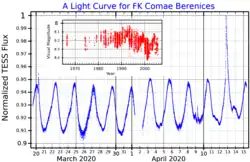 Light curves for FK Comae Berenices. The main plot shows the short term variability plotted from TESS data;[1] the inset, adapted from Panov and Dimitrov (2007),[2] shows the long term variability. | |
| Observation data Epoch J2000 Equinox J2000 | |
|---|---|
| Constellation | Coma Berenices |
| Right ascension | 13h 30m 46.79937s[3] |
| Declination | +24° 13′ 57.7862″[3] |
| Apparent magnitude (V) | 8.14 – 8.33[4] |
| Characteristics | |
| Spectral type | G4 III[5] |
| Variable type | FK Com[4] |
| Astrometry | |
| Radial velocity (Rv) | −21.0±5.8[5] km/s |
| Proper motion (μ) | RA: −51.969[3] mas/yr Dec.: −22.262[3] mas/yr |
| Parallax (π) | 4.6102 ± 0.0446 mas[3] |
| Distance | 707 ± 7 ly (217 ± 2 pc) |
| Absolute magnitude (MV) | 1.2[6] |
| Details | |
| Mass | 1.1[7] M☉ |
| Radius | 6.99[3] R☉ |
| Luminosity | 26.8[3] L☉ |
| Surface gravity (log g) | 2.359[8] cgs |
| Temperature | 4,966[3] K |
| Metallicity [Fe/H] | −0.89[7] dex |
| Rotation | 2.4 days[9] |
| Rotational velocity (v sin i) | 160[10] km/s |
| Other designations | |
| Database references | |
| SIMBAD | data |
FK Comae Berenices is a variable star that varies in apparent magnitude between 8.14 and 8.33 over a period of 2.4 days. It is the prototype for the FK Comae Berenices (FK Com) class of variable stars. The variability of FK Com stars may be caused by large, cool spots on the rotating surfaces of the stars. This star is thought to be the result of a recent binary merger, resulting in a high rate of both spin and magnetic activity.
The spectral class of FK Comae Berenices is G4 III, although it is considered unusual in having very broad absorption lines as well as some emission lines. The broadened spectral lines are due to rapid rotation.[10]
The rotation rate of FK Comae Berenices is unusually fast for a cool giant star. It is speculated that this is due to the merger of a contact binary pair of stars into a single star. The rotation produces extremely strong magnetic fields which are expected to brake the star to a slower rotation rate. Analysis of variability due to star spots on the surface show that the star rotates at different speeds at different latitudes.[9]
FK Comae Berenices is listed as a companion to the slightly brighter HD 117567. The two are not thought to be physically associated, with HD 117567 being a much closer F2 main sequence star.[12]
References
- ↑ "MAST: Barbara A. Mikulski Archive for Space Telescopes". Space Telescope Science Institute. Retrieved 8 December 2021.
- ↑ Panov, K.; Dimitrov, D. (May 2007). "Long-term photometric study of FK Comae Berenices and HD 199178". Astronomy and Astrophysics. 467: 229–235. doi:10.1051/0004-6361:20065596.
- 1 2 3 4 5 6 7 8 Brown, A. G. A.; et al. (Gaia collaboration) (August 2018). "Gaia Data Release 2: Summary of the contents and survey properties". Astronomy & Astrophysics. 616. A1. arXiv:1804.09365. Bibcode:2018A&A...616A...1G. doi:10.1051/0004-6361/201833051. Gaia DR2 record for this source at VizieR.
- 1 2 Samus, N. N.; Durlevich, O. V.; et al. (2009), "VizieR Online Data Catalog: General Catalogue of Variable Stars (Samus+ 2007–2013)", VizieR On-line Data Catalog: B/GCVS. Originally Published in: 2009yCat....102025S, 1: B/gcvs, Bibcode:2009yCat....102025S.
- 1 2 Strassmeier, Klaus G. (September 2009), "Starspots", The Astronomy and Astrophysics Review, 17 (3): 251–308, Bibcode:2009A&ARv..17..251S, doi:10.1007/s00159-009-0020-6.
- ↑ Korhonen, H.; Berdyugina, S. V.; Hackman, T.; Duemmler, R.; Ilyin, I. V.; Tuominen, I. (1999), "Study of FK Comae Berenices. I. Surface images for 1994 and 1995", Astronomy and Astrophysics, 346: 103, Bibcode:1999A&A...346..101K.
- 1 2 Anders, F.; Khalatyan, A.; Chiappini, C.; Queiroz, A. B.; Santiago, B. X.; Jordi, C.; Girardi, L.; Brown, A. G. A.; Matijevič, G.; Monari, G.; Cantat-Gaudin, T.; Weiler, M.; Khan, S.; Miglio, A.; Carrillo, I.; Romero-Gómez, M.; Minchev, I.; De Jong, R. S.; Antoja, T.; Ramos, P.; Steinmetz, M.; Enke, H. (2019), "Photo-astrometric distances, extinctions, and astrophysical parameters for Gaia DR2 stars brighter than G = 18", Astronomy and Astrophysics, 628: A94, arXiv:1904.11302, Bibcode:2019A&A...628A..94A, doi:10.1051/0004-6361/201935765, S2CID 131780028.
- ↑ McDonald, I.; Zijlstra, A. A.; Watson, R. A. (2017), "Fundamental parameters and infrared excesses of Tycho–Gaia stars", Monthly Notices of the Royal Astronomical Society, 471 (1): 770–791, arXiv:1706.02208, Bibcode:2017MNRAS.471..770M, doi:10.1093/mnras/stx1433.
- 1 2 Hackman, T.; Pelt, J.; Mantere, M. J.; Jetsu, L.; Korhonen, H.; Granzer, T.; Kajatkari, P.; Lehtinen, J.; Strassmeier, K. G. (2013), "Flip-flops of FK Comae Berenices", Astronomy & Astrophysics, 553: A40, arXiv:1211.0914, Bibcode:2013A&A...553A..40H, doi:10.1051/0004-6361/201220690, S2CID 118705220.
- 1 2 Ayres, Thomas R.; et al. (March 2016), "FK Comae Berenices, King of Spin: The COCOA-PUFS Project", The Astrophysical Journal Supplement Series, 223 (1): 30, arXiv:1601.03305, Bibcode:2016ApJS..223....5A, doi:10.3847/0067-0049/223/1/5, S2CID 118501523, 5.
- ↑ "FK Com". SIMBAD. Centre de données astronomiques de Strasbourg. Retrieved 2019-01-06.
- ↑ Mason, Brian D.; Wycoff, Gary L.; Hartkopf, William I.; Douglass, Geoffrey G.; Worley, Charles E. (2001), "The 2001 US Naval Observatory Double Star CD-ROM. I. The Washington Double Star Catalog", The Astronomical Journal, 122 (6): 3466, Bibcode:2001AJ....122.3466M, doi:10.1086/323920.